
Introduction
The Basilica of St. Fidelis, commonly known as the Cathedral of the Plains, is a Romanesque-style Roman Catholic parish church in Victoria, Kansas, United States. It was raised to the status of a Minor Basilica in 2014 and is also known as The Basilica of the Plains.
The presence of this large church on the Plains of Kansas is a lasting testimony to the faith and hard work of a people whose roots go deep into the soil of this farming community of Victoria.
The first settlers of this area were gentlemen farmers from England who arrived in 1872 with the intention of duplicating their aristocratic lives in spite of harsh weather and rough ground. They named their village, Victoria, in honor of their queen and laid out the streets according to the plan of London architect.
They were joined in 1876 by a group of poor immigrants from southern Russia known as Volga-Germans, who were fleeing from service in the Czar’s army and dangers to their Catholic faith. Creating a village of sod-huts adjacent to Victoria, they named it Herzog, after their town in southern Russia on the Volga River.
The British soon found pioneer life too extreme of a contrast with respect to the lifestyle they had known in England. They could not make the land adapt to them and they could not adapt to the demands of the land. In a few short years most returned home leaving the town’s name as the only lasting memorial to their efforts now in the care of the Volga-German community.
Hardened by their experience of a hundred years on the steppes of Russia, where they had first arrived at the invitation of Empress Catherine the Great in 1763; the Volga-Germans stayed to work with the land and make it their home.
History of the Present Church Building
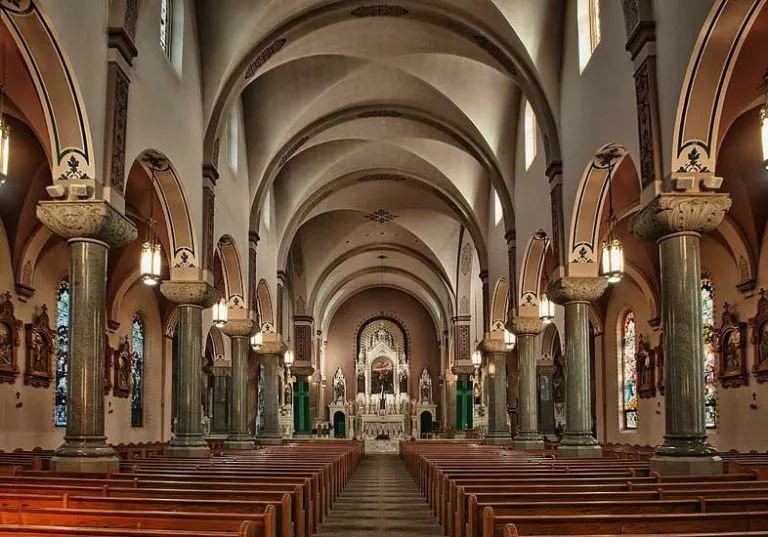
By the turn of the century the people found themselves in need of more space for community worship. Under the guidance of Father Jerome Mueller, OFM Capuchin, they decided to build a spacious and artistic church that would be a worthy house of God for present and future ages. To this end, the parish secured the services of one of the country’s foremost church architects, John T. Comes of Pittsburg. His plans were then slightly modified by architect John Marshall of Topeka.
Ground-breaking for the present church building was begun in November 1908 with Blanchard Construction Company of Topeka, Kansas, as the contractor with a bid of $49,375. However, the Blanchard Company fell into litigation and declared bankruptcy. A new contract bid of $54,785 by E.F.A. Clark Construction Company of Topeka, Kansas, was accepted in June 1909. They completed the construction in 1911.
The exterior is constructed of native limestone, quarried seven miles south of Victoria. Large layers of rock, about eight inches thick, were cleared of top soil and then perforated by hand augers with holes eight to ten inches apart. Into these holes, wedges were inserted and tapped with a hammer until the rock sprang apart along the line of perforation. The stone was then loaded on wagons and hauled to the building site to be dressed by local masons, who prepared it in fifteen different ways.
The Cathedral of the Plains
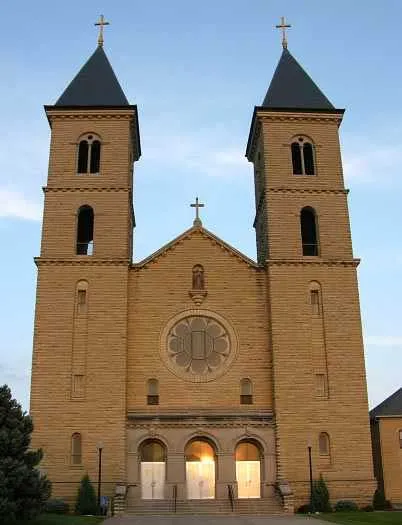
This massive Romanesque structure stands in the form of a cross facing to the west. Its majestic towers stand on the west end of the church. On the facade above the round rose window a statue of St. Fidelis, the patron saint of the church stands in a niche in the wall as if to keep watch. The church is 220 feet long including the steps, 110 feet wide at the transepts, and 75 feet high at the nave.
Its ceiling is 44 feet high above the floor level. The seating capacity is 1,100. The north and south side walls stand 27 feet high. The recessed walls on the north and south side stand 28 feet 4 inches in height from the base of the stone arches that support these walls and rest on the interior pillars. On these walls rest the main roof of the church.
The large round rose window of the west side of the church measure 13 feet in diameter and it is set in a two foot 6 inch circular stone arch. The round window on the north and south side in the transept measure 9 feet in diameter and are also set in a circular stone arch. The transepts measure 40 feet in length and 17 feet in width. The spacious sanctuary measures 38 feet in depth from the steps to the rear wall, 31 feet 10 inches wide in the recessed area then extends to the full width of the church where the side altars stand.
The Chapel in the rear of the church is 30 feet square with a five foot hallway on three sides. Large sacristies occupy the space on either side of the sanctuary. Originally wall space was provided for six confessionals. The two rear confessionals were never installed and instead the space was used for shrines. Some years ago one of the north confessionals was removed and in its place a side door entrance was installed.
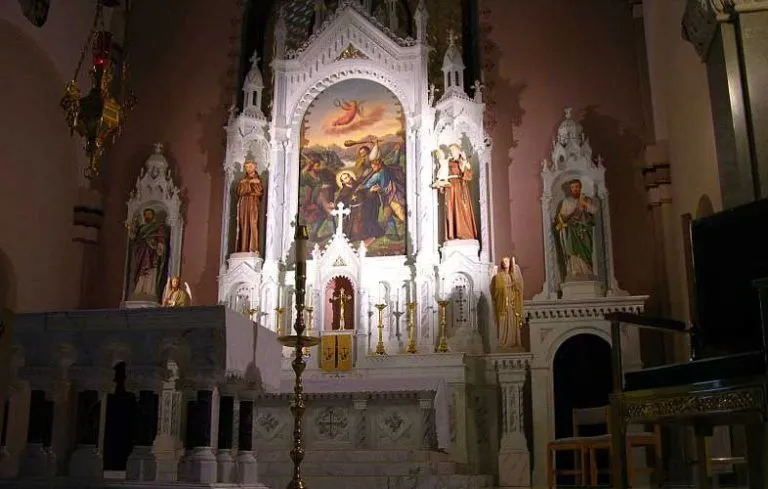
Recent Restoration
In 1994, the church began a series of restoration efforts. The congregation spent more than $265,000 on weather proofing the exterior, re-plastering and repainting the interior and updating the sound, electrical and heating systems. Work also included installing a marble floor in the sanctuary for $60,000 and replacing old carpeting and linoleum floors in other areas. The parish re-shingled the church roof in 2006 for $137,000.
In 2011, it replaced the parking lot and sidewalks for $225,000, and spent $70,000 on repairing the plaster ceilings and walls that had cracked with age. In 2013, an Arkansas company replaced plastic coverings that were installed in the mid-1980s to protect stained glass window from Kansas storms. As it aged, the plastic grew opaque, however the new coverings are tempered glass which will remain clear.
After approval by the Vatican in early March 2014, Bishop Edward Weisenburger of the Diocese of Salina dedicated St. Fidelis Church as a Minor Basilica on Saturday, June 7, 2014.
Saint Fidelis of Sigmaringen

Fidelis of Sigmaringen, O.F.M. Cap. (1577 – 1622) was a Capuchin friar who was involved in the Catholic Counter-Reformation, and was martyred by his opponents at Seewis im Prättigau, now part of Switzerland. Fidelis was canonized in 1746.
He was born Mark Roy or Rey in 1577, in Sigmaringen, a town in modern-day Germany, then under the Principality of Hohenzollern-Sigmaringen. His father’s name was John Rey. He studied law and philosophy at the University of Freiburg.
Roy subsequently taught philosophy at this university, ultimately earning the degree of Doctor of Law. During his time as a student he did not drink wine, and wore a hair-shirt. He was known for his modesty, meekness and chastity.
In 1604, Roy accompanied, as preceptor (teacher-mentor), three young Swabian gentlemen on their travels through the principal parts of Europe. During six years of travel, he attended Mass very frequently. In every town they came to, he visited the hospitals and churches, passed several hours on his knees in the presence of the Blessed Sacrament, and was generous to the poor, sometimes giving them the very clothes off his back.
Upon his return, he practiced law as a counselor or advocate, at Colmar in Alsace, France, where he came to be known as the ‘poor man’s lawyer’. He scrupulously forbore all invectives, detractions, and whatever might affect the reputation of any adversary. Disenchanted with the evils associated with his profession, he determined to join his brother George as a member of the Capuchin friars.

Life as a Friar
Upon entering the Capuchin order, the guardian gave him the religious name of Fidelis, the Latin word for “faithful,” alluding to that text from the Book of Revelation which promises a crown of life to him who shall continue faithful to the end. He finished his novitiate and studies for the priesthood, presiding over his first Mass at the Capuchin friary in Fribourg (in present-day Switzerland) on 4 October 1612 (the feast day of St. Francis of Assisi, founder of the order).
As soon as Fidelis finished his course of theology, he was immediately employed in preaching and in hearing confessions. He became guardian of the Capuchin friary in Weltkirchen, Feldkirch, (in present-day Austria). During a severe epidemic in a city, Fidelis cared for and cured many sick soldiers. Many residents of the town and neighboring places were reformed by his zealous labors, and several Calvinists were converted. The Congregation of the Doctrine of the Faith commissioned Fidelis to preach in the Graubünden region of eastern Switzerland. Eight other Capuchin friars were to be his assistants, and they labored in this mission under his direction.
The Calvinists of that territory, being incensed at his success in converting their brethren, loudly threatened Fidelis’ life, and he prepared himself for martyrdom. Ralph de Salis and another Calvinist gentleman were both converted by his missionary efforts. Fidelis and his companions entered into Prättigau, a small district of Graubünden, in 1622, on the Feast of the Epiphany, January 6. The effects of his ardent zeal, about which the Bishop of Coire sent a lengthy and full account to the Congregation for the Propagation of the Faith, enraged the Calvinists in that province.
On 24 April 1622, Fidelis made his confession, celebrated Mass and then preached at Grüsch. At the end of his sermon, which he had delivered with more than ordinary zeal, he stood silent all of a sudden, with his eyes fixed upon Heaven, in ecstasy. He foretold his death to several persons in the clearest terms, and began signing his letters, “P. Fidelis, prope diem esca vermium” (“Father Fidelis, in days ahead to become food for worms”). After the service at Grüsch he and several companions traveled to Seewis. His companions noted that he was particularly cheerful.

Death of Saint Fidelis
On 24 April, in a campaign organized by the Habsburgs, Fidelis was preaching under protection of some Austrian imperial soldiers in the Church at Seewis with the aim of reconverting the people of Seewis to Catholicism. During the sermon, his listeners were called “to arms” by the Calvinist agitators outside.
Some of the people went to face the Austrian troops outside the church. Fidelis had been persuaded by the remaining Catholics to immediately flee with the Austrian troops out of Seewis, which he did, but then returned alone to Grüsch. On his way back he was confronted by 20 Calvinist soldiers who demanded unsuccessfully that he renounce the Catholic faith, and when he refused, they subsequently murdered him.
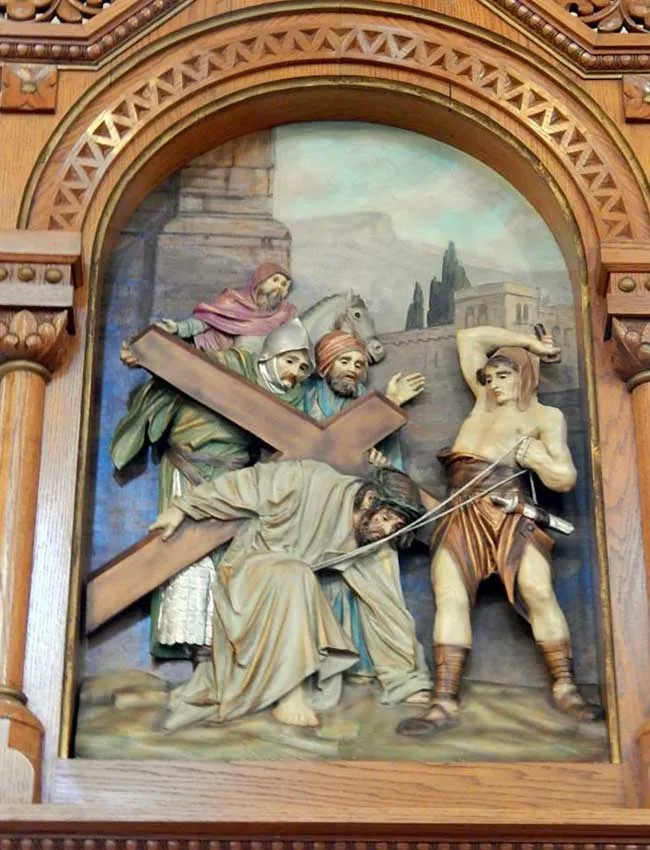
Veneration
It is said that a Catholic woman lay concealed near the place of Fidelis’ martyrdom as the saint was slain. After the soldiers had left, she came out to assess the incident and found the martyr’s eyes open, fixed on the heavens. He was buried by Catholics the next day.
The rebels were soon after defeated by the imperial troops, an event which the martyr had foretold. The Protestant minister who had participated in Fidelis’ martyrdom was converted by this circumstance, made a public abjuration of Calvinism and was received into the Catholic Church.
After six months, the martyr’s body was found to be incorrupt, but his head and left arm were separated from his body. The body parts were then placed into two reliquaries, one sent to the Cathedral of Coire, at the behest of the bishop, and laid under the High Altar; the other was placed in the Capuchin church at Weltkirchen, Feldkirch, Austria.
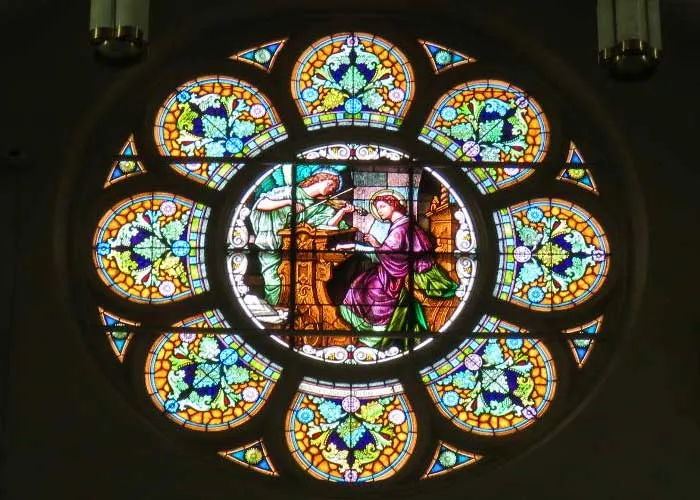
First Lighting System
As the church neared completion a carbide or acetylene lighting system was installed to furnish light for the church when evening services were to be held. The gas for the lights was formed by placing dry carbide in a specially designed underground tank and with water added the chemical action created a gas which was piped into the basement of the church. Two rows of plated pipes about seven feet high were placed down the center aisle of the church along the side of the pews and a row of pipes also stood along the outer walls.
They were all connected to the supply line. Each pipe was fitted at its top with a valve, a V-shaped burner and a glass shade. The lights were lit individually with a taper after the valve was opened to let the gas escape. The flame created a soft light and lit up the church to a degree so that the people could see fairly well. This was a common system used in churches, homes and business places and kept in use until electricity became available. In 1916 the church was wired for electric lights and the carbide system was removed.

Pews
The pews from the old church were installed in the new church. They were refinished and used until 1950 when they were replaced by one hundred and thirty-six new light oak pews. They were manufactured by a church furnishing company in Garnett, Kansas at a cost of $12,000.
Bells
The bells that summoned the faithful to church for services since 1884 were installed in the new church towers in 1911. The largest bell weighing 1300 pounds, one weighing 575 pounds and the smaller weighing 275 pounds. These bells harmonized beautifully and when the atmospheric conditions were right they could be heard for miles away. A small bell, christened St. Anthony, donated in 1910 was hung in the small tower above the choir or chapel.
It was used to summon the Friars to the choir for prayer. In more recent years another large bell was installed in the tower and to relieve the sacristan from ringing the bells by hand four electric motor bell ringers were installed. The sacristan walked many miles each year to and from the sacristy to ring the bells. The ropes hung in the vestibule of the church.
This equipment was purchased from the Verdin Machine Company, Cincinnati, Ohio at the cost of $1,900. A push of the button rings the bells, they can be rung in unison or rung individually as a toll bell for funerals. It has been noticed that since this system was installed the usual loud sound of the bells has been reduced and its carrying distance reduced.
Every morning at six a.m., at midday and at six p.m., the Angelus is rung reminding the faithful that is time to pray the Angelus. The pioneer families, regardless in what work they were engaged stopped and recited the angelus. This custom still prevails in many homes today. The bells are rung about 3000 times annually.

Painting
The cost of the first painting, finishing and fescoing amounted to $2,000. In 1943 the natural finished wood altars were painted white, trimmed with golf leaf paint and the parts of the altars having a round post structure were marbleized, likewise other parts were marbleized to beautify the looks of the altars. The communion railing was also painted white and the middle portion with the round legs were also marbleized to match the altars.
In the early 1950’s the interior was repainted under the supervision of Alex Linnenberger of Hays, Kansas. He was a native son born and raised in Victoria and a son of the late John J. Linnenberger. He was not only a painter but also an artist and painted a number of murals on the walls while the painting was done. He painted a number of churches in this community.
His sons, his brother Bonaventure and sons assisted in the painting. In 1979 the church underwent extensive repairs both on the exterior and interior. Downspouts were repaired and painted, and the parking lot was resurfaced. The interior walls were repaired and painted. The altars received a coat of paint and so did many of the statues. The color applied is a pleasing color for contrast. The cost of this work amounted to over $62,000. The money was made available by donations and fund raising projects. This was all done in about one year’s time.
Pipe Organ
In 1890 a pipe organ was installed in the previous church. Several registers were added later to enhance the tone quality. The cost of which was $1,000. This same organ was installed and used in the present church until 1941. Due to the cost of repairing the old pipe organ a new Hammond electronic organ was installed at a cost of $1,725. In 1973 this organ was replaced with a new Allen Computer 600 organ at a cost of $15,000.
Feast Day – 24th April
Saint Fidelis’ (Fidelis of Sigmaringen) Feast Day in the Catholic Church is celebrated on 24th April.
Mass Time
Mondays
Weekdays
Saturdays
Sundays
Church Visiting Time
Contact Info
900, Cathedral Avenue, Victoria,
Kansas, 67671, United States
Phone No.
Tel : +1 785-735-2777
Accommodations
How to reach the Basilica
Salina Regional Airport, formerly known as Salina Municipal Airport in Salina, Kansas, United States is the nearby Airport to the Basilica.
Garden City Amtrak Train Station in Garden City, Kansas, United States is the nearby Train Station to the Basilica.








